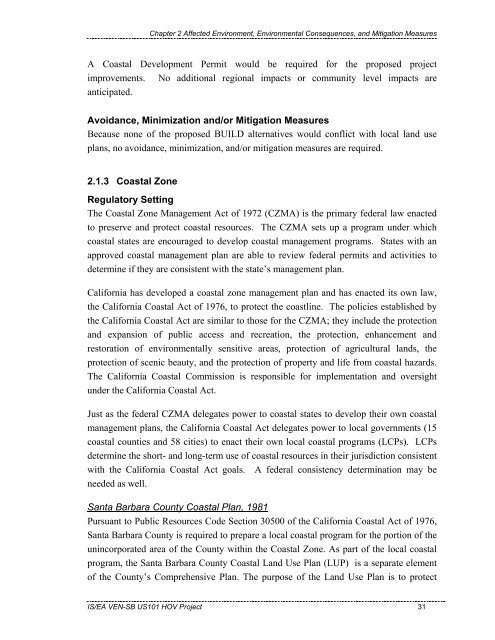Chapter 1 - Caltrans - State of California
Chapter 1 - Caltrans - State of California
Chapter 1 - Caltrans - State of California
Create successful ePaper yourself
Turn your PDF publications into a flip-book with our unique Google optimized e-Paper software.
<strong>Chapter</strong> 2 Affected Environment, Environmental Consequences, and Mitigation Measures<br />
A Coastal Development Permit would be required for the proposed project<br />
improvements. No additional regional impacts or community level impacts are<br />
anticipated.<br />
Avoidance, Minimization and/or Mitigation Measures<br />
Because none <strong>of</strong> the proposed BUILD alternatives would conflict with local land use<br />
plans, no avoidance, minimization, and/or mitigation measures are required.<br />
2.1.3 Coastal Zone<br />
Regulatory Setting<br />
The Coastal Zone Management Act <strong>of</strong> 1972 (CZMA) is the primary federal law enacted<br />
to preserve and protect coastal resources. The CZMA sets up a program under which<br />
coastal states are encouraged to develop coastal management programs. <strong>State</strong>s with an<br />
approved coastal management plan are able to review federal permits and activities to<br />
determine if they are consistent with the state’s management plan.<br />
<strong>California</strong> has developed a coastal zone management plan and has enacted its own law,<br />
the <strong>California</strong> Coastal Act <strong>of</strong> 1976, to protect the coastline. The policies established by<br />
the <strong>California</strong> Coastal Act are similar to those for the CZMA; they include the protection<br />
and expansion <strong>of</strong> public access and recreation, the protection, enhancement and<br />
restoration <strong>of</strong> environmentally sensitive areas, protection <strong>of</strong> agricultural lands, the<br />
protection <strong>of</strong> scenic beauty, and the protection <strong>of</strong> property and life from coastal hazards.<br />
The <strong>California</strong> Coastal Commission is responsible for implementation and oversight<br />
under the <strong>California</strong> Coastal Act.<br />
Just as the federal CZMA delegates power to coastal states to develop their own coastal<br />
management plans, the <strong>California</strong> Coastal Act delegates power to local governments (15<br />
coastal counties and 58 cities) to enact their own local coastal programs (LCPs). LCPs<br />
determine the short- and long-term use <strong>of</strong> coastal resources in their jurisdiction consistent<br />
with the <strong>California</strong> Coastal Act goals. A federal consistency determination may be<br />
needed as well.<br />
Santa Barbara County Coastal Plan, 1981<br />
Pursuant to Public Resources Code Section 30500 <strong>of</strong> the <strong>California</strong> Coastal Act <strong>of</strong> 1976,<br />
Santa Barbara County is required to prepare a local coastal program for the portion <strong>of</strong> the<br />
unincorporated area <strong>of</strong> the County within the Coastal Zone. As part <strong>of</strong> the local coastal<br />
program, the Santa Barbara County Coastal Land Use Plan (LUP) is a separate element<br />
<strong>of</strong> the County’s Comprehensive Plan. The purpose <strong>of</strong> the Land Use Plan is to protect<br />
IS/EA VEN-SB US101 HOV Project 31

















